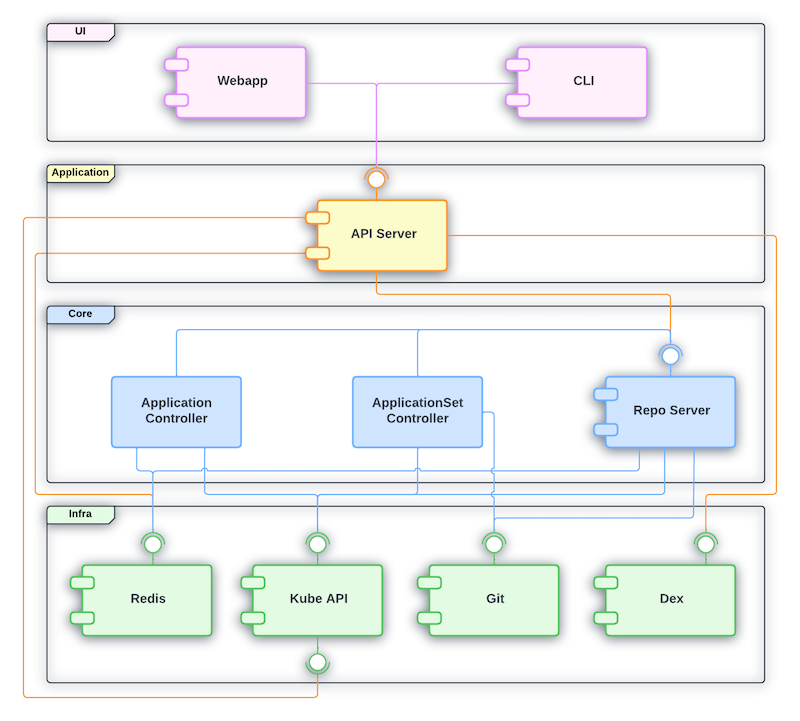Component Architecture¶
Argo CD is designed with a component based architecture. The goal is to separate the responsibility in different deployable units in order to have the following benefits:
- Modularity: Provides great level of flexibility. Components interact with each other via an interface. This means that as long as the interface contract is respected, a given component can be replaced without requiring the rest of the system to adapt. It is also possible to run the system without certain components if a specific group of functionality isn't desired.
- Single responsibility: Helps to determine where the different types of functionality should be implemented which drives for better system cohesiveness.
- Reusability: Clearly defined interfaces helps in functionality discoverability which benefits reusability of services.
The default Argo CD installation is composed by different components and different Kubernetes controllers. The controllers aren't categorized as components as they have proprietary interfaces (CRDs) and therefore, miss the modular nature. There are more resources created while installing Argo CD (ConfigMaps, Services, etc), but for simplicity we are covering just the ones directly related with the componentized architecture.
Dependencies¶
The diagram below has represented all dependencies between the different components used by the default Argo CD installation:

There are 4 logical layers represented in the diagram:
- UI: This is the presentation layer. Users interact with Argo CD mainly by components from this layer.
- Application: The capabilities required to support the components from the UI layer.
- Core: The main Argo CD gitops functionality is implemented by components and Kubernetes controllers from the Core layer.
- Infra: Represent the tools that Argo CD depends on as part of its infrastructure.
The logical layers also help making the diagram easier to follow as dependencies are represented in a top-down relationship. This means that components from the top layers will be allowed to depend on any component from any of the bottom layers. However components from the bottom layers will never depend on any ones from upper layers.
Responsibility¶
Below you can refer to a brief description of Argo CD components and its main responsibilities.
Webapp¶
Argo CD ships with a powerful web interface that allows managing applications deployed in a given Kubernetes cluster.
CLI¶
Argo CD provides a CLI that can be used by users to interact with Argo CD API. The CLI can also be used for automation and scripting.
API Server¶
Defines the proprietary API exposed by Argo CD that powers the Webapp and the CLI functionalities.
Application Controller¶
The Application Controller is responsible for reconciling the Application resource in Kubernetes synchronizing the desired application state (provided in Git) with the live state (in Kubernetes). The Application Controller is also responsible for reconciling the Project resource.
ApplicationSet Controller¶
The ApplicationSet Controller is responsible for reconciling the ApplicationSet resource.
Repo Server¶
Repo Server plays an important role in Argo CD architecture as it is responsible for interacting with the Git repository to generate the desired state for all Kubernetes resources that belongs to a given application.
Redis¶
Redis is used by Argo CD to provide a cache layer reducing requests sent to the Kube API as well as to the Git provider. It also supports a few UI operations.
Kube API¶
Argo CD controllers will connect to the Kubernetes API in order to run the reconciliation loop.
Git¶
As a gitops tool Argo CD requires that the desired state of the Kubernetes resources to be provided in a Git repository.
We use "git" here to stand in for an actual git repo, a Helm repo, or an OCI artifact repo. Argo CD supports all those options.
Dex¶
Argo CD relies on Dex to provide authentication with external OIDC providers. However other tools can be used instead of Dex. Check the user management documentation for more details.